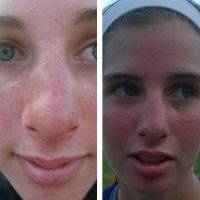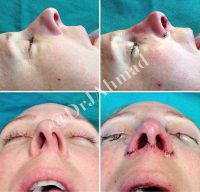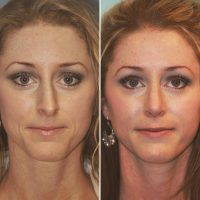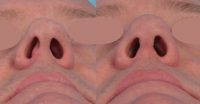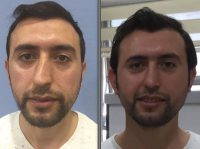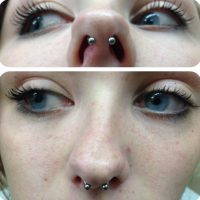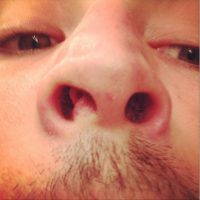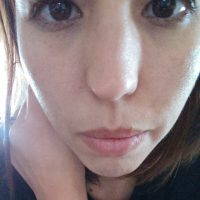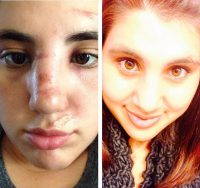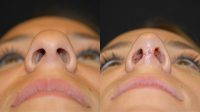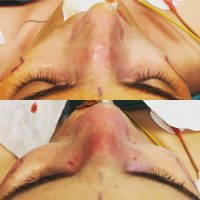Nose Looks Crooked After Rhinoplasty
The symmetry of the face, as a rule, largely determines its attractiveness. This view is based on an evolutionary model, suggesting that symmetry is an indicator of the stability of the genome and the genetic fitness of animals.
It is known that facial deformities cause biased perception of society, which is essential for human self-esteem. The loss of attractiveness often causes depressive state.
Thus, not surprisingly, deformation of face, that reduce its symmetry, can reduce self-esteem and quality of life of patients.
Patients tend to resort to reconstructive surgery for the correction of facial defects, in their opinion, adversely affecting their appearance, in order to restore symmetry.
It is known that the visual impact of facial symmetry on the perception of its beauty is greatly enhanced to the midline.
The farther deformation located from the midline, the less impact it has on the assessment of attractiveness.
Since the nose is located in the center of the face, patients with crooked nose are perceived as having an asymmetrical face. We can assume that the asymmetry of the nose has the maximum impact on the overall ranking of attractiveness.
Reasons for crooked nose
Crooked nose – a general term used to identify all deformations that are associated with a deviation of the nasal pyramid towards the front of the mid-sagittal plane, which passes through the middle of the nose, between the central incisors, along the seam and divides the face into equal halves.
In the history of the patient can be congenital deformities and traumatic damage to the nose. Of all the facial bones the nasal bones of the face most often exposed to fractures, and these fractures often lead to nasal deviation and aesthetic changes. Most often, the crooked nose is observed due to the septum deviation, different ways of deviation septum allows to straighten it.
Crooked nose can be hereditary and / or congenital. Some people are born with nasal curvatures as they compensate the asymmetry of the face. If the patient has an asymmetrical face and crooked nose to straighten the nose completely, face will look unbalanced.
In this case, a view to ensuring the most aesthetically pleasing results, surgeons prefer not to straighten the nose completely, leaving it with a slight curvature so that the face was in the balance.
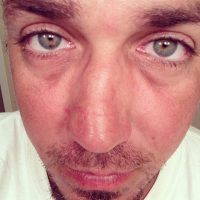
There Is Usually More Pronounced Swelling Afterward Correcting The Deviated Nose Than With Standard Rhinoplasty
Crooked nose can also be the result of rhinoplasty or asymmetric growth of the nasal structures. The nose, which has recessed elements may appear to be crooked, although the structure does not actually deviate from the median plane.
Sometimes deformation of the nasal septum occurs during childbirth.
How to straighten crooked nose?
Studies have shown that the surgical correction of the nasal asymmetry makes a person more attractive. Rhinoplasty in recent years become one of the major cosmetic surgery performed by plastic surgeons. The main indications for rhinoplasty are cosmetic and functional disorders.
Rhinoplasty is a complex and delicate operation from an aesthetic and functional point of view. For this reason, unfortunately, the level of secondary rhinoplasty is very high.
Crooked nose is the result of complex deformation of the structural elements, including bones of the nasal pyramid, upper and lower lateral cartilages and especially the nasal septum, which results in cosmetic and functional disorders. The main cause of curvature is a strong deviation of the nasal septum.
The curvature of the nose can occur in the upper or middle part and in the area of the tip.
The separation of the nasal pyramid into three sections in the upper, middle and bottom thirds, useful for defining the sectors in which anatomical structures are deformed.
The deformations can be divided into two main categories. These include bones deviation (upper third of the nasal) and deviation of cartilages (the lower two-thirds).
Bony abnormalities in the upper third of the can often be corrected by means of the controlled fracture of the nasal bones moving them to the midline or osteotomy.
The aim of osteotomy is to create a mobile bone segments, which can be returned to a favorable anatomical position and orientation. The risk of returning the bone to its original position is not high.
Abnormalities of the nasal cartilage (the lower two-thirds) are generally more difficult for correction. Most of the lower third of deviations include deviations of the base the nasal septum.
To correct the nose, is straightened its basis, which includes correction of nasal septum and nasal bones. When serious curvatures of the cartilage may need additional transplantation of the cartilage material.
Many patients with crooked nose suffer because of airway obstruction and the reconstructive surgery can benefit from for functional reasons. Many surgeons prefer to use an external or an open approach to the direct visualization of anatomical structures involved in the creation of the curvature of the nose, especially when the defect is considered to be severe.
Correction of crooked nose is a complex problem
One of the most difficult tasks of the rhinoplasty is the straightening of crooked nose.
Curvature may persist after primary rhinoplasty, or even after the secondary operation. The course of healing after rhinoplasty can be quite unpredictable. Usually secondary rhinoplasty to correct of postoperative deformations may require approximately in 2-5% of cases, but this rate may be higher in case of curvature of the nose.
There are several factors that complicate the correction of the curvature of the nasal structures. The first factor is the fact that the curvature of the cartilage and bone tissue have a certain level of memory. Cartilaginous tissue always retains a tendency to return to its original position.
There is a natural tension in the cartilaginous structures and soft tissues(shortened muscles and connective tissue on the side of the curve), while continuing to operate on the nose after rhinoplasty, which makes it difficult achieve excellent results after surgery.
Thus, nasal structure have a tendency to drift in the direction of initial position. Another factor that may lead to a return to its original curved shape is an incomplete correction of a deviated septum.
In addition, a deviation of the nasal septum may occur in conditions of facial asymmetry in congenital crooked nose.
This means that be difficult to find the true mid-sagittal plane in order to try to place the new position of the nose.
The tip of the nose is composed of cartilages, which often require transplantation and suturation for its straightening. Since this is the weakest of the nasal cartilages, and it is not attached to a solid structure, as the middle third, the curved tip is extremely difficult to fix.
If two protruding cartilage points that support the tip of the nose, too aggressively been removed, they will lose their elastic structure and the remaining cartilages begins to bend and twists. Trying to cut the cartilages only further weaken the structure of the tip of the long-term. Instead, the entire structure of the tip of the nose should be reconstructed.
Why does the nose looks crooked after rhinoplasty?
It is important to keep in mind that a completely straight nose is a very difficult task. After a significant improvement the nose can have a residual deviation or a small asymmetry. A small curvature is acceptable. The most a complicated goal is to make frontal view a symmetrical, since the incident light casts shadows, and the nose may look asymmetrical.
There are many reasons why the nose can become curved after rhinoplasty. This may be the result of drift of the nasal bone and / or asymmetric swelling of the soft tissue. Healing after rhinoplasty is a dynamic process.
The intensity of postoperative swelling may also vary in different parts of the nasal structures. Most of the swelling after rhinoplasty disappears within a month. Much more time is needed to resolve the final 20% of the swelling, up to a year or longer after surgery.
The final result of the surgery can be achieved after 18-24 months. Swelling after rhinoplasty largely depends on the structure of the nasal structures, surgical approach (open or closed / intranasal), skin thickness, postoperative care.
After an open rhinoplasty, when the external incision is made at the base of the nose, swelling is observed bigger and longer than after closed rhinoplasty. Patients with thick skin will have more swelling.
Swelling disappears under the influence of gravity, it means that the upper part of the back of nose narrowed of the first, swelling of the tip of the nose is preserved particularly long.
In general, the nose has some degree of swelling during the year. If the nasal septum straightened and well maintained, the nose initially looks straighter and then tend to deviate after some period of time.
It can greatly disappoint of the patient, he / she may to think first that the correction was successful. First the swelling will hide abnormalities that may become more apparent after over time.
Secondary rhinoplasty is aimed at correcting deformities that were not considered in the first operation, such as a deviated septum, which can make the nose distorted, or resulting from wrong or improper healing after rhinoplasty.
Rhinoplasty always includes two separate procedures, on right and left sides of the nose. The asymmetry may be due to non-uniform correction of the sides, varying intensity of scarring during the healing process.
- Crooked Nose After Septoplasty Photo
- Crooked Nose After Open Rhinoplasty
- Crooked Nose After Deviated Septum Surgery
The curvature may result from the excessive removal of cartilage on one side. The deviation of the nasal septum can be fixed. Secondary rhinoplasty may include transplantation of cartilages.
Some surgeons recommend the injection of fillers to correct asymmetry or postoperative irregularities. However, such injections increase the risk of scarring that may jeopardize the success of a possible secondary rhinoplasty. Permanent fillers hamper the subsequent receipt of a smooth contour of the nose. Temporary fillers are absorbed by the body after 8 to 12 months.
The end result of rhinoplasty can be seen after 12 months of observation. If after surgery of the nose curvature persists, should wait 6-9 months before you start the secondary rhinoplasty. Too early surgery can lead to new problems. Five-year period for a rhinoplasty may be sufficient to assess the long-term results.


